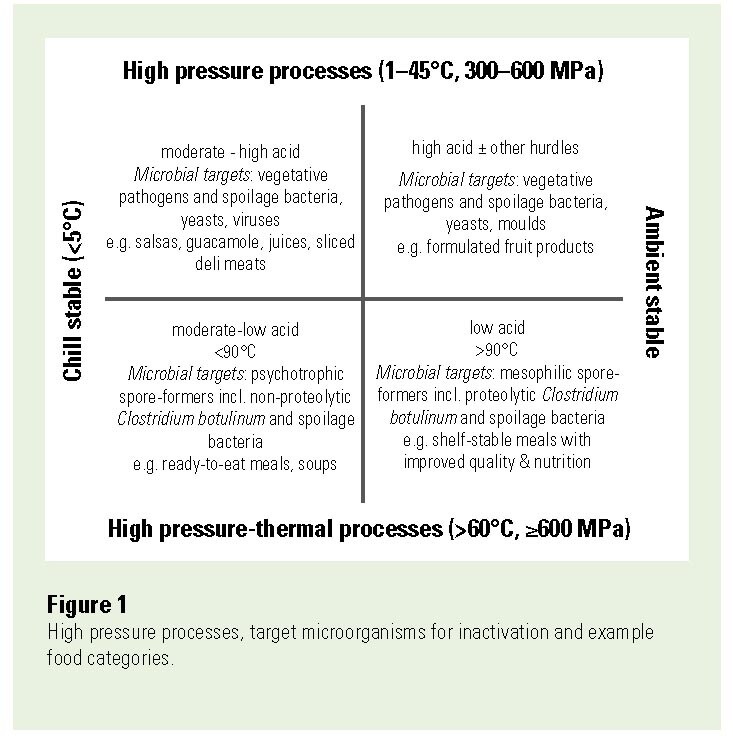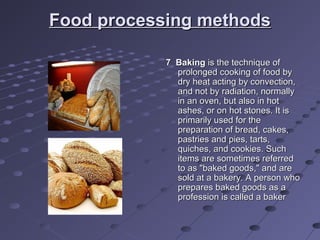

Farmed product may be handled somewhat differently from wild-caught product. Harvested product may be processed on shipboard or stored by icing or freezing for transport to the processing plant. There are many elements of production of fish products that generate solid and liquid wastes. Most of the waste content is biodegradable carbohydrates, although salts may also be a contributor for some such as brining products. The production process produces waste streams from washing and rinsing, sorting, in-plant fluid transport methods, peeling, pureeing and juicing, blanching, canning, drying, cooking and cleanup. Many of the aforementioned treatment processes are used in vegetable and food processing wastewater. Recycling where food contact is involved is more problematic between processes because different contaminants may be contributed. The safety of the food product is paramount, and recycling within a process step can be allowed by law for certain food processes, such as chiller water in meat and poultry processing. Detergents or other additives may be employed for those nonfood contact applications, which may improve or complicate the subsequent treatment processes. In-plant recycling can also be employed since water is in demand for not only processing steps, but also for cleaning equipment, facilities and floors. "The safety of the food product is paramount, and recycling within a process step can be allowed by law for certain food processes, such as chiller water in meat and poultry processing." In addition, many wastes or treated residues are amenable for land application as beneficial soil amendments or fertilizers, which can mitigate much of the wastewater discharge concerns however, even those approaches can be problematic if excessive nutrient runoff occurs, particularly in cold weather. They include: flotation, coagulation, sedimentation, filtration, adsorption, membranes, primary settling, secondary activated sludge, anaerobic digestion and even recovery of carbon dioxide or methane for subsequent uses. Both oxidative and anaerobic processes may be employed. The types of treatment technologies used for food processing wastewater are not unusual among wastewater treatment options and include the typical array of biological and physical chemical treatments. Treatment technologies for food processing wastewater So, each waste type will have special factors to consider, and in addition to the technology performance issues, seasonality of production adds to the complexities of the treatment choices and operations in several industries. Biochemical oxygen demand (BOD) and chemical oxygen demand (COD) values for many wastes are in the thousands of milligrams per liter, and some like cheese production, winery and olive milling can be in the tens of thousands for COD. Industry examples include: meat and poultry products, dairy products, fruits and vegetables for canning and preserving, grain products, sugar and related confectionaries, fats and oils, and beverages and brewing, among others. The range of food and agricultural wastes present different challenges.

“Each type of food processing wastewater will have special factors to consider, and in addition to the technology performance issues, seasonality of production adds to the complexities of the treatment choices and operations in several industries.” Plant-food processing wastes may be lower strength and greater volume than animal processing and animal production. In the U.S., it is subject to effluent guidelines requirements and National Pollutant Discharge Elimination System (NPDES) permits.


It must be treated to levels that will not damage receiving waters due to excessive nutrients or oxygen demand when directly discharged or will not disrupt publicly owned treatment works (POTWs) when discharged to sewers. It is also among the most difficult and costly waste to manage because food processing wastewater can contain large quantities of nutrients, organic carbon, nitrogenous organics, inorganics, suspended and dissolved solids, and it has high biochemical and chemical oxygen demands. Wastewater generated from food production and agricultural activities is a major source of environmental pollution.


 0 kommentar(er)
0 kommentar(er)
